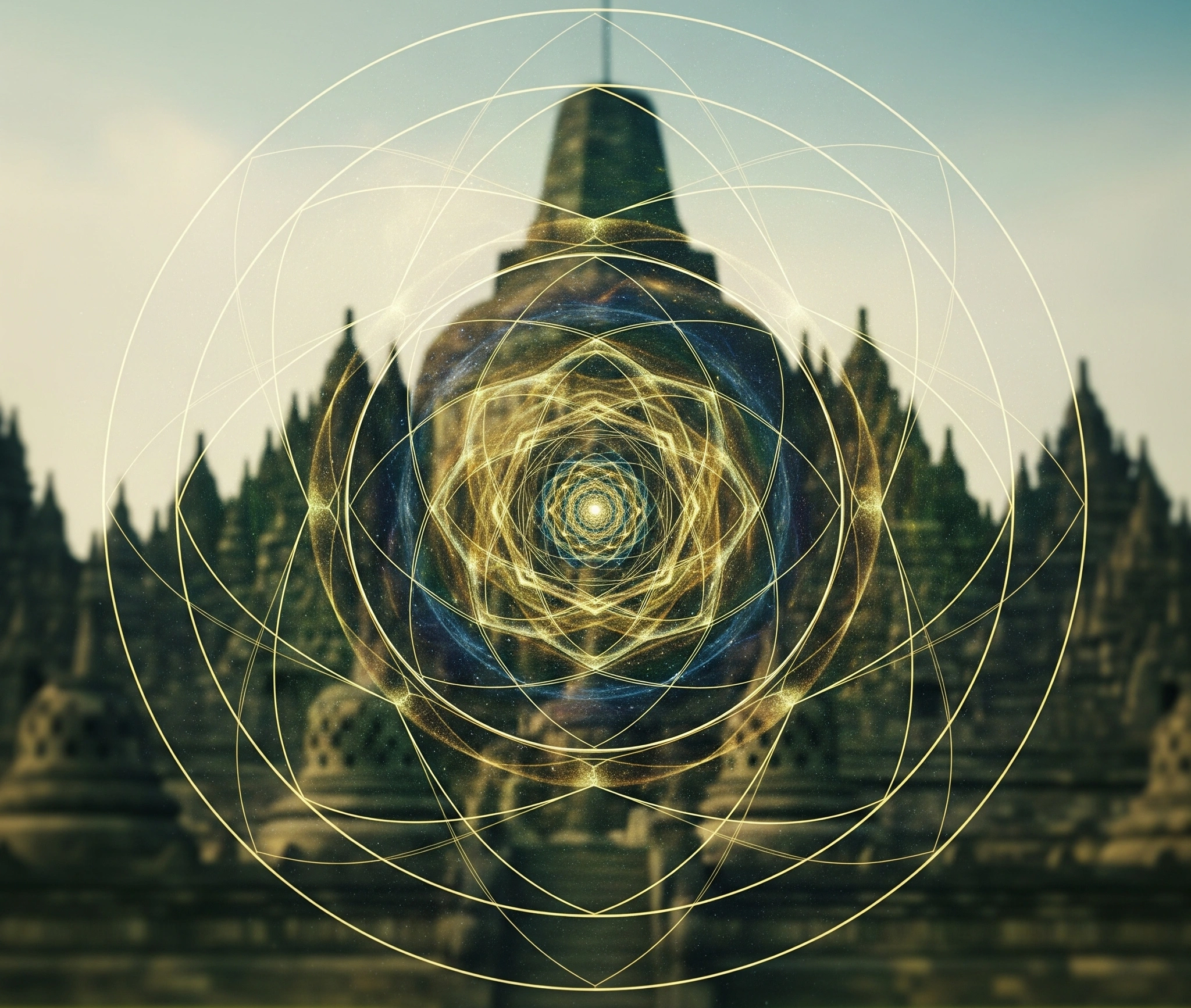When we gaze upon the intricate designs of Java’s ancient temples, do we see mere decorative patterns or something more profound? For centuries, the precise layouts of these monumental structures have puzzled observers, sometimes attributed to random artistry or even supernatural intervention. Yet, beneath the surface of their aesthetic beauty lies a hidden language: the language of mathematics and cosmology. This article delves into the true nature of Javanese sacred geometry, revealing the underlying principles that guided their construction. This isn’t about arbitrary patterns; instead, it’s a journey into the profound mathematical and spiritual wisdom that truly shaped these timeless masterpieces.
Table of Contents
- What is Sacred Geometry in Javanese Temple Architecture?
- Unveiling the Patterns: Key Principles of Javanese Sacred Design
- Borobudur and Prambanan: Masterpieces of Sacred Geometry in Action
- Actionable Solutions: Integrating Sacred Geometry Principles Today
- The Timeless Relevance of Sacred Geometry in the Digital Age
- Returning to the Blueprint of Existence
What is Sacred Geometry in Javanese Temple Architecture?
Sacred geometry, in the context of Javanese temple architecture, refers to the application of specific mathematical ratios, geometric shapes, and cosmological principles in the design and layout of religious structures. These principles were not merely aesthetic choices. Instead, they were believed to imbue the temples with spiritual power and align them with universal harmony. Ancient Javanese civilizations, influenced by Indian philosophical and architectural treatises, meticulously planned their temples to reflect a profound understanding of the cosmos.
Origins and Foundational Principles
The roots of Javanese sacred geometry trace back to ancient Indian texts like the Vastu Shastra and Shilpa Shastras. These texts provided detailed guidelines for temple construction, emphasizing cosmic alignment, proportional systems, and symbolic forms. Javanese architects and spiritual leaders adapted these principles, integrating them with local beliefs and artistic expressions. The concept of the *mandala*, a geometric configuration representing the cosmos, was central. Similarly, the idea of Mount Meru, the mythical cosmic mountain, often served as the symbolic core for temple designs.
Core components of this design philosophy included precise proportions and ratios, sometimes reflecting the Golden Ratio or specific numerical sequences. Orientation played a crucial role, with temples often aligned to cardinal directions or significant astronomical events. The use of fundamental shapes like squares, circles, and triangles was also highly symbolic. Philosophically, these temples were seen as microcosms of the universe. They represented a path to enlightenment or a spiritual journey that pilgrims undertook by navigating the temple’s physical layout. This approach reveals knowledge, not magic; it serves as a guide, not a prophecy, for understanding ancient human achievement in design.
Unveiling the Patterns: Key Principles of Javanese Sacred Design
The intricate beauty of Javanese temples is a direct result of their adherence to specific principles of sacred geometry. These principles guided every aspect of their design, from the overall layout to the smallest decorative detail.
Mandala Principle: The Cosmic Diagram
The Cosmic Diagram: Order from Chaos
Many Javanese temples, particularly Buddhist ones, follow a mandala layout. This geometric configuration represents the universe in its ideal form. The design often features concentric squares or circles, symbolizing a journey from the outer, mundane world towards the enlightened center. This principle provides a structured path for spiritual progression. The duality lies in the representation of both the ordered cosmos and the individual’s chaotic journey towards that order.
Proportional Harmony: Ratios and Dimensions
Ratios and Dimensions: Aesthetic and Spiritual Balance
Javanese temple builders employed sophisticated proportional systems. They applied specific ratios to determine the height, width, and spacing of various temple elements. These ratios often connected to cosmological numbers or even human body proportions, creating a sense of natural harmony and balance. This ensured not only aesthetic beauty but also spiritual efficacy. The paradox is that these precise mathematical structures were meant to evoke a sense of the infinite and divine.
Orientation and Alignment: Connecting to the Cosmos
Connecting to the Cosmos: Earthly Points, Celestial Paths
The orientation of Javanese temples was meticulously planned. Builders aligned them with cardinal directions, significant sunrises or sunsets, or specific celestial events. This alignment was believed to connect the earthly structure to cosmic energies and divine influences. For example, temples often face east, towards the rising sun, symbolizing enlightenment. This principle bridges the fixed human creation with the dynamic movements of the universe.
Symbolic Carvings and Reliefs: Narrating the Journey
Narrating the Journey: Art as Spiritual Guide
Beyond their structural geometry, the temples’ surfaces are adorned with rich symbolic carvings and reliefs. These are not merely decorative. Instead, they are integral to the spatial narrative, guiding the pilgrim through various spiritual stages. Each panel and sculpture holds meaning, reinforcing the philosophical journey represented by the temple’s layout. This highlights the dualities of art as both aesthetic expression and profound spiritual instruction.
Borobudur and Prambanan: Masterpieces of Sacred Geometry in Action
To truly grasp the application of sacred geometry in Java, we must examine its most celebrated examples: Borobudur and Prambanan. These structures are not just architectural wonders; they are living textbooks of ancient Javanese sacred design.
Borobudur’s Cosmic Mandala
Borobudur, the world’s largest Buddhist temple, built around the 9th century CE, is a prime example of a three-dimensional mandala. Its unique stepped pyramid structure, rising from a square base to circular terraces, meticulously guides the pilgrim through a spiritual ascent. The transition from square to circle symbolizes the journey from earthly existence to spiritual liberation. The precise dimensions, the number of levels, and the arrangement of stupas and Buddha statues all adhere to a complex geometric and numerical system, making the entire temple a profound cosmic diagram for meditation and enlightenment.
Prambanan’s Tripartite Harmony
Prambanan, Indonesia’s largest Hindu temple complex, constructed shortly after Borobudur, showcases sacred geometry within a different cosmological framework. Its layout emphasizes a tripartite division, mirroring the Hindu Trimurti (Brahma, Vishnu, Shiva). The three main temples are arranged on a central axis, with smaller shrines surrounding them in a precise, symmetrical pattern.The axial alignment and the precise spacing between structures create a harmonious balance, reflecting the cosmic order and the interconnectedness of the divine realms in Hindu philosophy. This demonstrates a sophisticated understanding of spatial relationships and symbolic representation.
Actionable Solutions: Integrating Sacred Geometry Principles Today
Understanding the profound principles of Javanese sacred geometry offers more than historical insight. It provides a framework for bringing order, harmony, and meaning into our modern lives. Real transformation requires concrete action. The principles that guided the placement and design of Java’s temples can inspire our own journey toward greater balance and intentionality.
Mindful Design in Daily Life
Practice: Consciously observe and appreciate geometric patterns in both nature and built environments. Recognize how symmetry, proportion, and balance affect your feelings.
Application: Apply principles of balance and proportion to your personal spaces. Declutter your living area or workspace to create a sense of order. Consider how the layout of your digital files or even your daily schedule can be more harmonious.
Philosophical Meaning: Cultivating awareness of underlying order brings inner peace. It helps you create environments that support clarity and well-being, reflecting the temple builders’ intention.
Structured Approach to Goals
Practice: Apply a “mandala-like” structure to your personal or professional projects and goals. Visualize your objectives with a clear center and progressive layers.
Application: Define your central purpose (the “dome” or core aim). Then, break it down into concentric layers of objectives and tasks. Ensure each step builds logically towards the core vision. This helps in project planning.
Philosophical Meaning: This approach provides clarity, reduces overwhelm, and ensures all efforts contribute to a unified vision. It mirrors the spiritual ascent represented by temple layouts.
Seeking Balance and Alignment
Practice: Regularly check for balance in various aspects of your life. Consider your work-life balance, rest-activity balance, and the balance between giving and receiving.
Application: Use a simple daily check-in or weekly review. Align your actions with your core values and long-term goals. Prioritize activities that bring you into a state of equilibrium.
Philosophical Meaning: This practice emulates the cosmic alignment of temples, fostering inner equilibrium and purpose. It promotes a harmonious existence, much like the balanced designs of ancient structures.
The Timeless Relevance of Sacred Geometry in the Digital Age
The principles of sacred geometry, once used to build monumental temples, offer crucial insights for navigating our contemporary world. In an era often characterized by chaos, information overload, and a search for meaning, understanding underlying order can provide stability and direction.
Modern design, from urban planning to user interface (UI) design, often unconsciously employs principles akin to sacred geometry. Architects and designers utilize balance, proportion, and visual flow to create aesthetically pleasing and functional spaces. Data visualization benefits from structured layouts that make complex information digestible. Therefore, consciously applying these ancient principles can lead to more harmonious and intuitive designs in various fields. The benefits extend beyond aesthetics, promoting mental clarity, reducing anxiety by creating a sense of order, and enhancing creativity. Ultimately, understanding sacred geometry provides a framework for appreciating the interconnectedness of art, science, and spirituality, fostering a deeper sense of purpose in a fragmented world.
 Returning to the Blueprint of Existence
Returning to the Blueprint of Existence
The ancient temples of Java are not just architectural wonders; they are profound expressions of a civilization’s understanding of cosmic order. Their layouts and designs, guided by sacred geometry, reveal a deep reverence for mathematical precision and spiritual harmony. By unlocking these blueprints of belief, we gain a deeper appreciation for the ingenuity of ancient builders. This wisdom teaches us that true beauty and lasting impact arise from a conscious alignment with universal principles. It reminds us that even in our complex modern lives, seeking underlying order can lead to profound clarity and purpose.
“Geometry is knowledge of the eternally existent.”
— Pythagoras
Call to Action
Uncover the spiritual power of nature and ancient sites!
Context and References
Internal Links to Related Articles:
- Read more about the history of ancient Javanese kingdoms.
- Explore the symbolism of mandalas in world cultures.
- Discover the principles of ecological architecture.
External References (If Applicable):
- UNESCO World Heritage Centre: Borobudur Temple Compounds
- UNESCO World Heritage Centre: Prambanan Temple Compounds
- Britannica: Sacred Geometry – Britannica
- Vastu Shastra: Vastu Shastra – Wikipedia
Disclaimer:
This content is provided for cultural, historical, and architectural understanding. It explores the mathematical and philosophical principles behind Javanese temple design, emphasizing human ingenuity and spiritual insight, rather than literal interpretations of divine intervention.
About the Author/Source:
This architectural and philosophical insight is shared by The Architect of Harmony — a symbolic figure representing deep respect for design, mathematical precision, and spiritual integration. These writings are meticulously crafted by the [Your Website Name] team, comprised of cultural researchers, architectural historians, and spiritual practitioners dedicated to preserving and translating ancient wisdom into a relevant format for contemporary generations. We believe that ancestral heritage is not merely a relic, but a compass for living in harmony with our world. Each article is written through a process of extensive research, expert consultation, and deep contemplation, to ensure accuracy and the profound nobility of its contained values. Learn more about our authors and philosophy.
